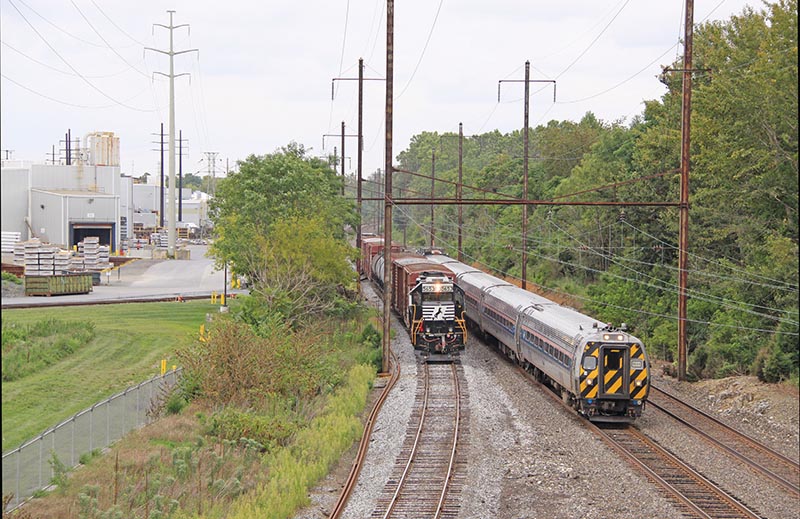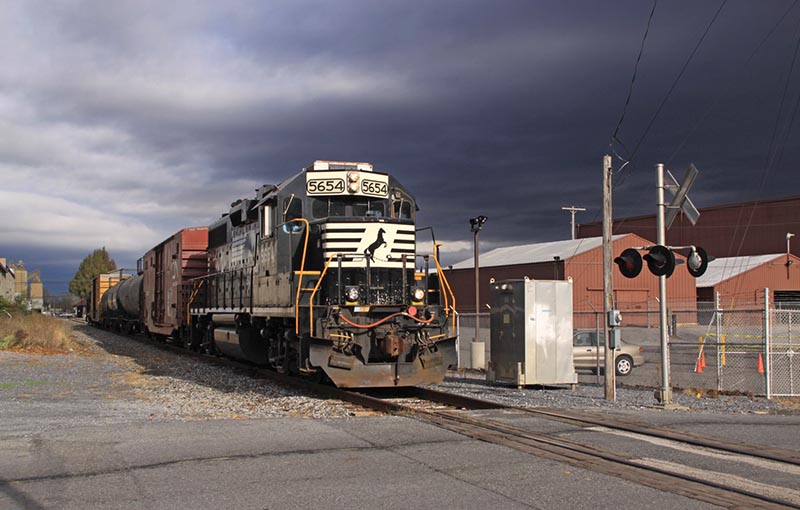 by Mark W. Hoffman/photos by the author
by Mark W. Hoffman/photos by the author
Lancaster County, Pennsylvania, features a robust economy anchored by a mix of industry, agriculture and tourism in the south-central part of the Commonwealth. Norfolk Southern’s Lititz Industrial Track touches activities of all three of these sectors on its scenic 13.6-mile route from Lancaster to Lititz.
Weekday turn-train H23 originates at Lancaster from Lewis Yard (aka Lancaster Yard) and switches five customers to Lititz during daylight on an active 13.6-mile segment of the former Reading Company’s Reading & Columbia Branch. Speed on the mostly jointed-rail line, restricted to not exceed 10 MPH, provides great chasing opportunities. Attractive farmsteads and historic buildings along the route, including stations at Manheim and Lititz, offer great props to be worked into photo compositions.
NS designates the Lititz Industrial Track as north-south, with outbound trains to Lititz northbound and inbound trains returning to Lancaster south-bound. Geographically, the line is shaped like a giant “C,” first heading west from Lancaster, then north to Manheim, and eventually eastward to Lititz.

ABOVE: PUSH-PULL TWOFER— After switching Alumax at left (now Arconic Mill Products), NS H23 has reassembled its train and will soon return to Dillerville Yard (now Lewis Yard). NS GP38-2 5653 trails the nine-car train and NS GP38-2 5655 leads on the head end. Meanwhile on Amtrak’s Philadelphia-Harrisburg line, Keystone Service train 643 zips westward at 12:12 p.m., Wednesday, August 25, 2010. Cab-control car 9644 leads four Amfleet as AEM-7 921 shoves in this elevated view at Lancaster from the busy McGovernville Road (PA 741) overpass. The continuous welded rail sections were staged to replace the old jointed rail on the Lititz Industrial Track here where the line parallels Amtrak.
Historical Summary
The Lititz Industrial Track was originally part of the Reading Company’s Reading & Columbia Branch, which diverged from Reading’s Lebanon Valley Line (today’s NS Harrisburg Line) at Sinking Spring, Pennsylvania. Four segments of the old “R&C” survive: the northernmost segment from Sinking Spring through Denver to Stevens, operated by East Penn Railway (ESPN); the Lititz – Lancaster segment by NS; a two-mile segment south of the Amtrak (former Pennsylvania Railroad) Keystone Corridor by the Landisville Railroad; and two miles in Columbia by shortline Columbia & Reading Railway (CORY).
The Reading & Columbia Railroad was originally built to connect the City of Reading to the Chesapeake Bay Region via the Susquehanna Tide Water Canal. Trains began running on the R&C in 1863. In the early years, it transported mainly coal, iron ore and general merchandise, and scheduled as many as 10 passenger trains a day.

ABOVE: MARKETPLACE— Returning to Lancaster, NS H23 stops traffic at the Graystone Road grade crossing at 11:07 a.m., Wednesday, July 21, 2010. The old mill building at the Root’s Country Market & Auction complex makes a great prop. The former Reading Company wooden signal shanties at the crossings have since dis-appeared along the line, replaced by metal boxes.
Regular passenger service on the Reading & Columbia Branch, which included use of motor cars, ended on November 5, 1950. The Reading’s first Ramble excursion operated over the R&C as part of an extensive routing on Sunday, October 4, 1936. Several Reading passenger excursions ran on the branch after regular passenger service ceased, through the early 1960s.
The Reading discontinued regular steam operations, which included camelback locomotives on the R&C, in 1956. This ended the need for the water tank at Manheim, where its brick base remains. A combination of factors led to the Reading Railroad’s bankruptcy in 1971. The decline of anthracite coal traffic, the rise of trucking companies and the Interstate highway system, government regulations, and the Penn Central merger removing Reading’s bridge traffic with other railroads, all were financially devastating.

ABOVE: ANGRY SKIES— Dark clouds predominate on a blustery autumn day as NS H23 slips through Manheim at 3:43 p.m., Thursday, October 23, 2014. Operating pull-pull, NS GP38-2 5654 leads and NS GP38-2 5659 trails the five-car train southward at the South Penn Street grade crossing. Despite passing through an industrial area, rail sidings cease to exist in this area. The Manheim station can be seen in the background behind the end of the train.
Conrail on its start-up day of April 1, 1976, assumed operations of the majority of Reading’s railroad assets, including the Reading & Columbia Branch. Immediately, the line was taken out of service from the north end of Lititz to the north end of Akron. This step ended through freight service on the line between Reading and Lancaster, a common Conrail practice of “sever-and-wither”
Tour of the Line
The H. Craig Lewis Yard (formerly Dillerville) at Lancaster builds and originates the H23 locals serving the Lititz Industrial Track. Crews usually refer to this facility as Lancaster Yard. Some of these moves can be observed from the Dillerville Road overpass, known as the Captain Edward Anthony Davis Memorial Bridge, where it passes over the yard’s east end and Amtrak’s Keystone Corridor. Use extreme caution when photographing along this busy roadway.
Under current NS locomotive assignments, one or two rebuilt GP38-2s, SD40Es and/or SD60Es power the locals. Prior to 2019, pairs of four-axle GP38-2s were the common model of motive power based on the freight locals working out of Lancaster Yard.

ABOVE: CONFECTIONERY LANDMARK— During the runaround move, Norfolk Southern GP38-2 5279 and SD60E 6977 approach the North Broad Street grade crossing in Lititz, Pennsylvania, at 10:49 a.m., Tuesday, April 8, 2025. The billboard-style lettering on the brick building recalls its heritage as a chocolate manufacturing plant. This sidewalk view from along North Broad Street (PA 501) at Lititz looking west offers a close-up view of the move.
NS local crew H23 is called at Lancaster Yard at 7:00 a.m., Monday – Friday. After making up its train, usually in the east yard, the train shoves eastward in a reverse move out either No. 1 or 2 Industrial Track to Amtrak’s CORK Interlocking. Depending on Amtrak traffic, H23 may hold at Lancaster Station, typically on the No. 7 freight bypass track. When clear, H23 will crossover to No. 2 Track on Amtrak at CORK and head west to Amtrak’s LITITZ Interlocking, typically between 7:30 – 9:30 a.m.
The Lititz Industrial Track diverges from Amtrak at LITITZ Interlocking, just east of the U.S. 30 overpass. H23 is usually onto the branch at approximately 8:30 – 9:30 a.m. The branch parallels Amtrak about 200 feet to the north for a half mile, then returns to closely parallel the Amtrak main for a quarter mile, running under the catenary structure (but without overhead wire). For the most part, this portion of the line is inaccessible without trespassing, and runs through a tunnel of trees…



